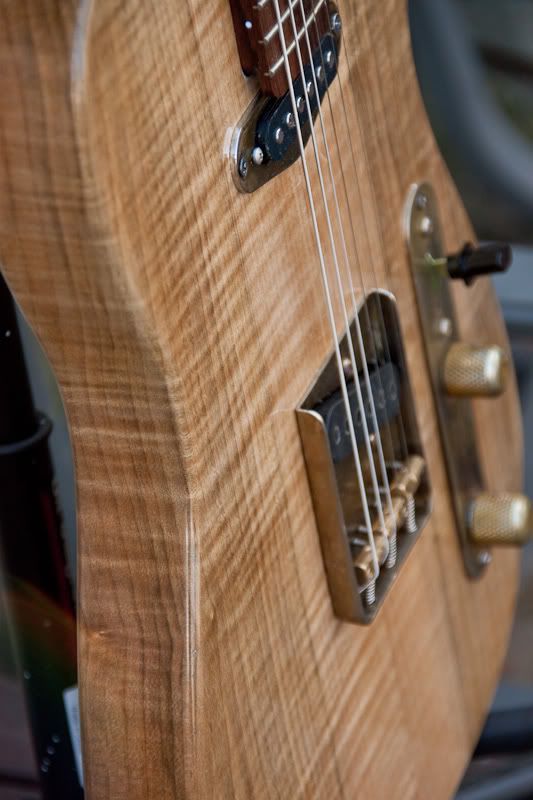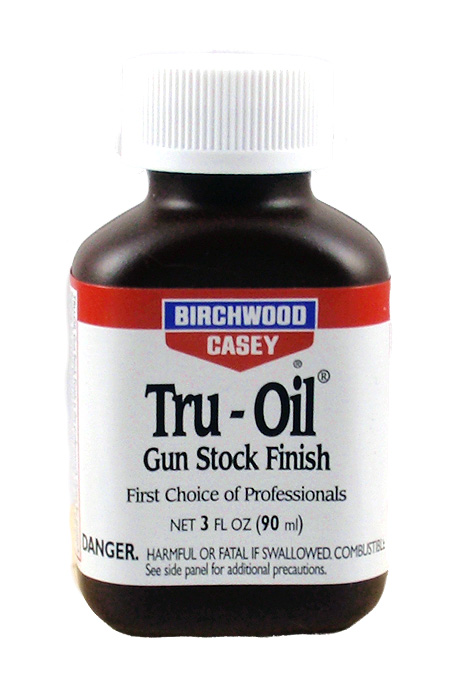Tru-Oil is the brand name for a wipe on varnish made by Birchwood Casey. Originally developed as a gunstock finish, it’s relative ease of application, decent durability, and grain enhancing properties, have won it a lot of favor among guitar finishers.
There also seems to be a lot of confusion about it too. I think that comes from the fact that there’s lots of conflicting information out there. I know I was somewhat confused about the best methods to use it the first time I tried it. Part of the confusion comes from some people using the name Tru-Oil and tung oil interchangeably. And to add to that confusion, many manufacturers use the term tung oil to represent products that contain many different additives, and even some that don’t contain tung oil. I think the strong association of Tru-Oil with tung oil comes mainly from the fact that they are applied in a similar way and very similar finish characteristics. And probably also because they both start with the letter ‘T’.
Tru-Oil, as far as my research has shown, contains no tung oil. It’s a blend of various things, mostly boiled linseed oil, mineral spirits, and oil varnish. It works well for finishing any wooden parts of the guitar. The way it fills in the grain, and it’s slight amber tint, tend to really highlight woods beauty. And just a few coats on the back of a neck feels really nice and makes a fast playing neck that won’t get sticky when you start sweating.
Here’s a Tele partscaster I finished in Tru-Oil.

As with most other finishes, surface prep is key is you want to end up with a smooth glossy finish. So you still need to go through the same grainfilling and sanding steps you’d take if you were finishing with nitro or some kind of water based lacquer. A neat trick you can do with Tru-Oil at this stage is to use it as the grainfiller. The method, is to put a somewhat heavy coat of Tru-Oil on, then let it dry for 24 hours. Then, sand the Tru-Oiled surface with 400 grit sandpaper, using more Tru-Oil as a sort of lubricant, and using circular motions over a small section at a time. This “slurry” of Tru-Oil and sawdust will fill in the grain and seal itself as it dries. Used this way, it can be a grain filler for a finish of nitrocellulose clear lacquer. Just give the Tru-Oil a few days to fully cure before starting with your lacquer topcoats. You generally don’t want to use water-based finishes over Tru-oil. Of course, a lot of people who use oil finishes prefer the look of open grain. This is fine, you just won’t get a mirror type finish. Tru-Oil may not cure over Cocobolo due to it’s high oil content. As with any finish, if in doubt, test it on some scrap wood of the same type you will be doing your finish on.
Tru-Oil is very easy to apply once the surface is properly prepped. No special equipment is needed, you just wipe it on. You can use any lint free rag, your fingers, or my preferred method – a paper coffee filter. Coffee filters work especially well as they don’t soak up a lot of oil. Most problems people have with Tru-Oil, is from putting it on too thick. The coffee filters are also very cheap, usually a couple dollars for 100 of them, so you can use a fresh one with each coat. Some people have mentioned having problems with the cheapest filters “shedding” fine paper lint into the oil. I haven’t seen this problem, but if you do, the brown, unbleached filters are recommended.

When you first open the bottle of Tru-Oil, don’t pull off the tinfoil seal. Instead, just punch a small hole with a needle or something similar. The reason for this is that it doesn’t dry by having the solvents in it evaporate. It cures by reacting with oxygen. And it cures FAST. You don’t want to have the bottle sitting open while you work. Once that skin of cured Tru-Oil starts forming inside your bottle, it will become more difficult to get a really smooth glossy finish. I think because the oil is partly cured at that point, it doesn’t level as well. If I’m doing a large surface, like a guitar body, I will pour some Tru-Oil into a small jar and mix it about 50/50 with mineral spirits. This slows the drying some and makes it even easier to put on a really thin coat.
If you’d like to try out Tru-Oil, I recommend starting with a neck, preferably one with a rosewood fingerboard. The rosewood doesn’t need a finish, so you’ll just be treating the back of the neck and head, and won’t have to deal with getting the oil between all the frets. This can take a little more finesse to get nice even coverage, without having it pool up around the fretwire. It only takes a few coats to protect the neck wood, and so more coats for a smoother finish and glossier appearance, are just a matter of preference. I usually put 3-6 coats on a neck, which leaves some of the grain texture, giving it a satin finish and a nice silky smooth feel.



This is an interesting site and recommendations in the use of Tru-oil seem to correlate with mine. I have yet to explore its potential as I agree with what you (?) said about its aesthetic qualities, albeit it doesn’t offer the protection of harder curing lacquers such as nitro, waterborne and, oh, those hideous polys.
I am exploring the idea of spraying this product as it would render very fine coat levels. Using a gravity gun with an 1.2 setup, this might prove to be workable. If the oil is used in a dedicated gun it might be feasible to leave the oil in the cup until the project is complete, say, for instance, shooting many fine layers to the point enough is enough. There would be little chance of curing in the gun as no oxy would ingress through the cup’s lid or via the nozzle as the needle seats perfectly, thus ensuring no air intake. Thinning the finish to the right viscosity might be a bit of test-and-see and since this is essentially a linsead and varithane type of product, mineral spirit (in the UK we refer to it as white spirit) would seem the ideal agent, although someone mentioned acetone as an option which I would regard as being potentially a health hazard! It flashed off quickly for sure but not for me. It might not be compatible with Tru-oil’s constituents.
have you considered this method of application,or tried it?
I haven’t tried spraying TruOil myself but I know of others who have had success with it. You can actually buy it in an aerosal can ready to spray. Otherwise, your right, that mineral spirits is the thinner of choice if mixing your own.